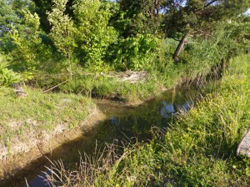Establishing a Biotope Reserve on Our Factory Site (Hitachi Construction Machinery Tierra)
Hitachi Construction Machinery Tierra Co., Ltd. is located in Shiga Prefecture, the home of Lake Biwa. The company is embarking on various environmental initiatives, including conservation of the ecosystem.
In 2013, we created an ecosystem map of our factory site. Since then, we have been updating this map. We use the map to familiarize our employees with the animals we identified in the area. Recently, we observed a Japanese wild rabbit (lepus brachyurus). In the waterfront area we identified other species endemic to the area, including freshwater prawns (palaemon paucidens), Japanese crayfish (cambaroides japonicas) and Japanese ricefish (Oryzias latipes).
Furthermore, we planted vegetation in an embankment made from topsoil when we carried out construction to expand our parking lot. We also embarked on the development of a biotope. Along 700m² of the embankment, we planted around 30 trees, including bayberries (myrica rubra), trees that attract stag beetles (lucanidae) and rhinoceros beetles (dynastinae), and other trees that produce nectar that is a source of food for the Japanese white-eye (zosterops japonicus), a small bird, and Japanese bush warbler (horornis diphone). In 10-20 years down the road, the trees we plant should grow into a forest.
Lately, rhinoceros beetles have become somewhat of a rarity. We hope that this forest biotope will become home to these beetles in the future.
Hitachi Construction Machinery Tierra Co., Ltd. is located in Shiga Prefecture, the home of Lake Biwa. The company is embarking on various environmental initiatives, including conservation of the ecosystem.
In 2013, we created an ecosystem map of our factory site. Since then, we have been updating this map. We use the map to familiarize our employees with the animals we identified in the area. Recently, we observed a Japanese wild rabbit (lepus brachyurus). In the waterfront area we identified other species endemic to the area, including freshwater prawns (palaemon paucidens), Japanese crayfish (cambaroides japonicas) and Japanese ricefish (Oryzias latipes).
Furthermore, we planted vegetation in an embankment made from topsoil when we carried out construction to expand our parking lot. We also embarked on the development of a biotope. Along 700m² of the embankment, we planted around 30 trees, including bayberries (myrica rubra), trees that attract stag beetles (lucanidae) and rhinoceros beetles (dynastinae), and other trees that produce nectar that is a source of food for the Japanese white-eye (zosterops japonicus), a small bird, and Japanese bush warbler (horornis diphone). In 10-20 years down the road, the trees we plant should grow into a forest.
Lately, rhinoceros beetles have become somewhat of a rarity. We hope that this forest biotope will become home to these beetles in the future.


